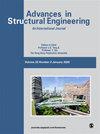椭圆双高斯和模型下倾角喷雾膜厚度的数值模拟和实验研究
IF 2
4区 工程技术
引用次数: 0
摘要
针对倾斜角喷涂时的涂膜厚度增长率建模问题,在高斯和模型的基础上,提出利用椭圆双高斯和模型建立喷枪静态倾斜角喷涂时的涂膜厚度累积模型。利用微分几何放大定理建立了以喷涂倾角为变量的涂层增长率模型;随后进行了静态倾斜喷涂实验,通过喷涂实验记录了采样点的涂层厚度数据,并利用 Levenberg-Maquart 算法对模型进行了最小二乘拟合,得到了静态喷涂膜厚分布模型。最后,与椭圆双 β 模型相比,通过比较 R 方值,在倾斜角喷涂时,椭圆双高斯和模型的拟合精度比椭圆双 β 模型高 6.3%,椭圆双高斯和模型更能获得较好的拟合精度,这进一步证实了该模型的有效性和实用性。本文章由计算机程序翻译,如有差异,请以英文原文为准。
Numerical simulation and experimental study of dip angle spray film thickness under elliptical double Gaussian sum model
To address the problem of modeling the growth rate of coating film thickness when spraying at inclination angle, based on Gaussian sum model, it is proposed to use the elliptic double Gaussian sum model to establish the cumulative model of coating film thickness when spraying at static inclination angle of the spray gun. The differential geometry amplification theorem is used to establish the coating growth rate model with the spraying inclination angle as the variable; after that, the static inclination spraying experiments are carried out, and the coating thickness data of the sampling points are recorded through the spraying experiments, and the Levenberg-Maquart algorithm is used for the least-squares fitting of the model, which results in the static spraying film thickness distribution model. Finally, compared with the elliptic double β model, the fitting accuracy of the elliptic double Gaussian sum model is 6.3% higher than that of the elliptic double β model when spraying at inclination angle by comparing the R-square values, and the elliptic double Gaussian sum model is more capable of obtaining a better fitting accuracy, which further confirms the validity and practicability of the model.
求助全文
通过发布文献求助,成功后即可免费获取论文全文。
去求助
来源期刊

Advances in Mechanical Engineering
Engineering-Mechanical Engineering
自引率
4.80%
发文量
353
期刊介绍:
Advances in Mechanical Engineering (AIME) is a JCR Ranked, peer-reviewed, open access journal which publishes a wide range of original research and review articles. The journal Editorial Board welcomes manuscripts in both fundamental and applied research areas, and encourages submissions which contribute novel and innovative insights to the field of mechanical engineering
 求助内容:
求助内容: 应助结果提醒方式:
应助结果提醒方式:


